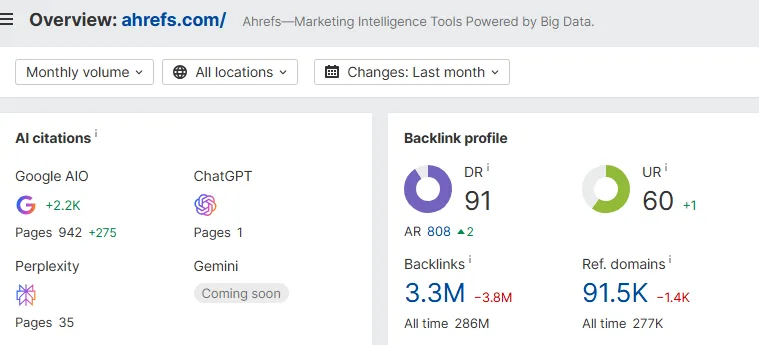Unlocking DA vs DR Guest Posting Solution Beginner’s Guide
SEO experts, including those at Guest Posting Solution, often rely on crucial factors between DA vs DR for effective website ranking. Many agencies use these metrics to measure the success of new campaigns or compare ongoing ones. However, for beginners, the difference between DA vs DR can be tricky. In this guide for beginners about Domain Rating vs Domain Authority, we’ll break down these essential SEO metrics.
Guest Posting Solution will cover everything you need to know, from explaining what they are to why they matter in SEO. So, let’s jump in and explore the basics without any delay.
What is DA, and how does it work?
DA stands for Domain Authority, a way to predict how well a website might rank in search engines. Moz created this metric, and it’s like a scorecard for websites. The higher the DA score, the better the chances the website ranks high on search engines.
In the past, DA worked straightforwardly. However, Moz has become more advanced to meet the needs of bloggers, SEO experts, and webmasters. It predicts a website’s ranking by looking at over 170 factors. Things like the number and quality of links pointing to a website are part of these factors.
Moz calculates a website’s DA score on a scale that goes up in a tricky way called logarithmic. Moving from a DA score of 60 to 70 is much more complicated than going from 10 to 20. Understanding DA helps determine a website’s performance in search engine rankings.
How do you increase the DA score of a website?
Want to boost your website’s Domain Authority (DA) score? To enhance the DA score of a website, web administrators, bloggers, or SEO experts at Guest Posting Solution focus on various factors. To achieve a higher DA score, experts at Guest Posting Solution consider the following key points:
Here are some simple tips for web admins, bloggers, or SEO experts:
- Domain Age: Older websites generally have a better shot at impressing search engines. So, if your website has been around for a while, that’s a plus.
- Quality Backlinks: Pay attention to the links pointing to your site. It’s not just about the number; it’s about quality. Aim for backlinks from websites with a higher DA score. Also, having one good backlink from a website is better than having many from the same site.
- Mobile-Friendly Design: Google loves websites that work well on mobile devices. So, make sure your website is mobile-friendly. This can positively impact your DA score.
- Social Signals: The more your content gets shared on social media, the better your DA score. Social signals, like shares, contribute to a higher score. At Guest Posting Solution, we implement all these practices.
- Content Quality and Quantity: What you say and how much you say it matter. More high-quality content on your website is a surefire way to boost your DA score.
In addition to these, SEO experts and webmasters should also focus on the technical aspects and off-page and on-page SEO. Improving these areas can work wonders for increasing your website’s DA score without diving into complex jargon.

How do you measure the DA score of a website?
Calculating a website’s Domain Authority (DA) score involves using Moz’s built-in tool, the Moz DA checker. This tool, although free, has a limitation: it doesn’t let users check the DA score of multiple websites simultaneously. To address this, users can turn to alternative tools such as the DA PA Checker, a free domain authority checker that enables checking 20 websites in a single go.
What is DR, and how does it work?
DR stands for Domain Rating, a metric by Ahrefs that assesses a website’s backlinks profile quality. It indicates how good the backlinks supporting a website are. A higher DR score suggests a website has a top-notch backlinks profile.
Unlike Moz’s DA metric, Ahrefs’ DR is simpler. Yet, its functioning is much like Moz’s DA. Both metrics aim to evaluate and predict a website’s ranking, with DR focusing on the quality of backlinks.
Unlike the DA score, the Domain Rating (DR) doesn’t involve many factors. It focuses on specific things:
- The number of do-follow links pointing to the main website.
- The Domain Rating (DR) of all websites linking to the main website.
- The number of other websites linking to the main website.
- The number of pages from a domain that point to the main website.
Ahrefs rates a website’s DR on a scale from 1 to 100, where 1 is the lowest and 100 is the highest. However, according to Guest Posting Solution SEO experts, even the best websites rarely achieve a perfect 100 DR, as it is more of a theoretical concept.
How do you increase the DR score of a website?
Guest Posting Solution highlights the factors that can impact these metrics:
- Increase the number of do-follow links to your main website.
- Use links from websites with a higher Domain Rating (DR).
- Get more websites to link to your main site.
- Increase the number of web pages from a domain pointing to your main website.
How to calculate the Domain Rating of a website?
Calculating a website’s Domain Rating (DR) using Ahrefs involves these steps:
- Ahrefs uses its built-in capabilities to calculate DR.
- It considers factors like the number of links and the quality of links.
- Ahrefs applies mathematics and coding algorithms to calculate the raw Domain Rating.

Guest Posting Solution is Clarifying Common Misconceptions:
Despite the DA vs DR guide, there is lingering confusion about these third-party metrics. Let’s address the primary misunderstandings:
- Google doesn’t use Domain Authority (DA) and Domain Rating (DR) to rank web pages. So, focusing solely on increasing DA and DR may not impact your site’s Google rankings.
- Contrary to belief, a website’s Domain Rating (DR) isn’t connected to its number of keywords. The number of keywords doesn’t influence DR.
- No-follow links don’t contribute to an increase in a website’s Domain Rating (DR).
- Multiple links from the same domain don’t boost a website’s Domain Rating (DR).
Difference Between DA and DR:
As third-party metrics, Domain Authority (DA) and Domain Rating (DR) come with certain limitations.
At Guest Posting Solution, let’s explore these downsides:
- These metrics offer an incomplete view of a website’s overall performance.
- Domain Authority (DA) lacks precision in gauging the true ranking power of a blog or website.
Influencing Factors on DA and DR Metrics:
Understanding the factors that manipulate DA and DR is crucial for web administrators and SEO practitioners. DA and DR fluctuate wildly because they are influenced by various factors such as changes in the backlink profile, algorithm updates, and the dynamic nature of online content.
Here are factors that can impact these metrics, and at Guest Posting Solution, we carefully consider these elements in our SEO strategies:
-
Quality Backlinks:
Acquiring high-quality backlinks from reputable websites positively influences DA and DR metrics. It indicates that your site is considered valuable by authoritative sources.
-
Content Quality and Relevance:
Creating and maintaining high-quality, relevant content boosts your website’s standing. Search engines recognize your value, contributing to improved DA and DR scores.
-
Consistent Content Updates:
Regularly update and add fresh content signals to search engines that your site is active and relevant. This consistency contributes positively to DA and DR metrics.
-
Mobile-Friendly Design:
Search engines prioritize mobile-friendly websites. Optimizing your site for mobile devices positively impacts DA and DR scores.
-
Social Signals:
Engaging in social media and garnering social shares indicates your content’s popularity. This social validation contributes to favourable DA and DR metrics.
-
Technical SEO Optimization:
Technical SEO Optimization, a key practice at Guest Posting Solution, involves optimizing a website’s technical elements to enhance visibility and performance in search engine results. This encompasses optimizing factors like site speed, crawlability, and mobile-friendliness, and addressing technical issues to positively impact search engine rankings.
Choosing Between DA and DR:
In wrapping up our detailed comparison between DA vs DR, the question is: which one should you focus on? Moz, the trailblazer in search engine stats with DA, used to be the preferred choice among Guest Posting Solution and other SEO experts. It showcased a site’s efficiency in reaching high ranks on search engines.
However, the current trend leans towards DR. Ahrefs’ DR metric, which has gained popularity for its user-friendly nature and offering accurate and actionable data. AhrefsBot diligently notes outbound links during website crawls, determining quantity and quality. While DA is susceptible to manipulation using dubious SEO tactics, DR remains robust, aligning well with Google rankings. SEO experts, like those at Guest Posting Solution, recommend prioritizing DR over DA for more reliable insights and strategic SEO decisions. Choose wisely for a more effective SEO strategy.






